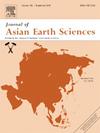Dominant wind patterns shaping grain-size records at IODP Site U1430 in the East (Japan) Sea since the early Pleistocene: Northwesterly surface winds vs. upper westerlies
IF 2.7
3区 地球科学
Q2 GEOSCIENCES, MULTIDISCIPLINARY
引用次数: 0
Abstract
Grain-size records of detrital components at IODP Site U1430 in the East (Japan) Sea, spanning the last 2.3 million years, are examined to understand how variations in the intensity of the East Asian Winter Monsoon influenced these records through two distinct dust-transporting wind patterns: low-level northwesterly winter monsoon winds and upper-level westerlies. By applying end-member (EM) modelling to grain-size distributions, we identified five EMs corresponding to fine-mode dust carried by upper-level westerlies (EM1), coarse-mode dust transported by northwesterly surface winds (EM2), and marine tephra of varying modes (EM3, EM4, and EM5). To isolate the dust components, we excluded marine tephra contributions and developed a dust-size distribution model based solely on EM1 and EM2. The mean size variations of this modeled dust at Site U1430 exhibited strong consistency in both cyclicity and amplitude, with similar stacked size records from the Chinese Loess Plateau (CLP). Given that the CLP size records near the source deserts were primarily influenced by northwesterly surface winds, the synchronization between these records and those from Site U1430 suggests that the records from Site U1430 were also predominantly governed by changes in the intensity of northwesterly surface winds rather than upper westerlies. The spatial variations in size records from the loess sections across the CLP, along with modern dust size observations, imply that the vertical and lateral sorting of dust during uplift and downwind transport likely contributed to the smaller dust sizes recorded at Site U1430.
求助全文
约1分钟内获得全文
求助全文
来源期刊

Journal of Asian Earth Sciences
地学-地球科学综合
CiteScore
5.90
自引率
10.00%
发文量
324
审稿时长
71 days
期刊介绍:
Journal of Asian Earth Sciences has an open access mirror journal Journal of Asian Earth Sciences: X, sharing the same aims and scope, editorial team, submission system and rigorous peer review.
The Journal of Asian Earth Sciences is an international interdisciplinary journal devoted to all aspects of research related to the solid Earth Sciences of Asia. The Journal publishes high quality, peer-reviewed scientific papers on the regional geology, tectonics, geochemistry and geophysics of Asia. It will be devoted primarily to research papers but short communications relating to new developments of broad interest, reviews and book reviews will also be included. Papers must have international appeal and should present work of more than local significance.
The scope includes deep processes of the Asian continent and its adjacent oceans; seismology and earthquakes; orogeny, magmatism, metamorphism and volcanism; growth, deformation and destruction of the Asian crust; crust-mantle interaction; evolution of life (early life, biostratigraphy, biogeography and mass-extinction); fluids, fluxes and reservoirs of mineral and energy resources; surface processes (weathering, erosion, transport and deposition of sediments) and resulting geomorphology; and the response of the Earth to global climate change as viewed within the Asian continent and surrounding oceans.
 求助内容:
求助内容: 应助结果提醒方式:
应助结果提醒方式:


